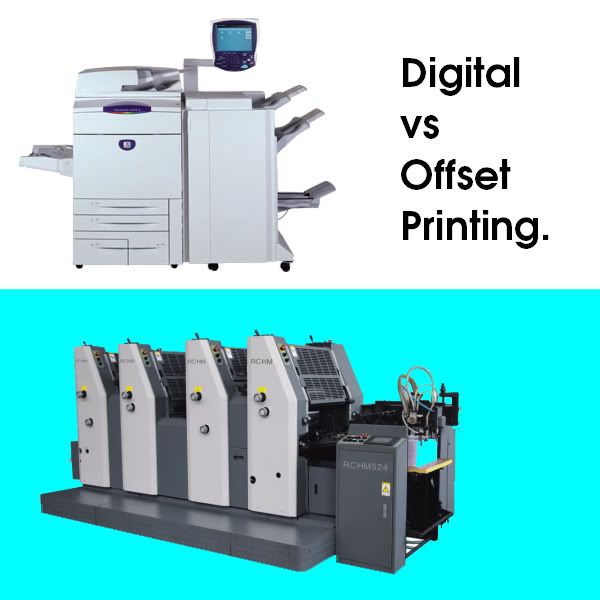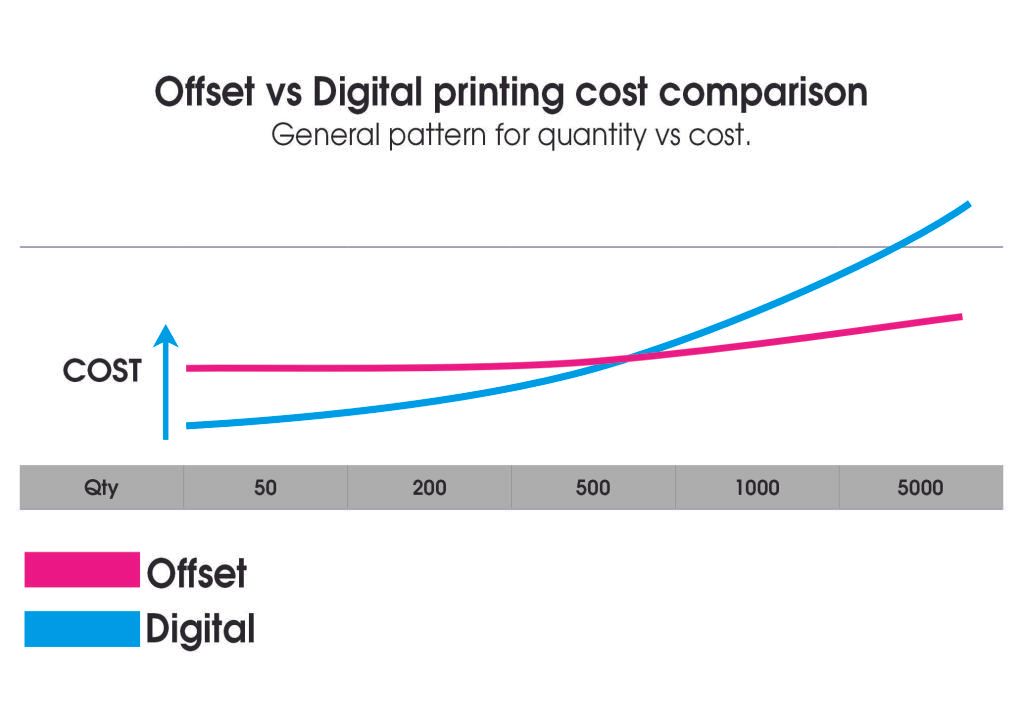WHAT'S THE DIFFERENCE BETWEEN OFFSET AND DIGITAL PRINTING?

I will never forget being asked a very valid question when I first started as graphic designer in a printing firm many years ago.
A friend asked, "Will all your printing be digital printing?" ummmm I stammered trying to think what he meant. “There's different kinds of printing?” I thought to myself, I mean you send the artwork to a printer and it prints, that’s all I know!
All the while my mind was racing to find an answer that closely resembled someone who had studied a 3 year degree in graphic design.
I had to come clean and ask what he meant by digital printing.
His expression was a little bewildered and my embarrassment was valid.
I should've known, I mean graphic designers design for print all the time but it never ceased to amaze me how little many “graphic designers” understood about the printing process.
The number one culprit - yours truly.
There are in fact 2 forms of printing on paper stocks each with benefits and pitfalls that most people should at least be aware of, customers included. Here is a surface look at the two kinds.
The 2 major forms of printing are 'Digital' & 'Offset'.
Digital printing.
Digital printing is a term used for any print job that is created from a softcopy (not physical) like the birthday card that you recently designed and sent digitally to the printer next to you. This could be an ink jet printer or a laser printer. The print out is created from a digital copy of your artwork. Many print shops, offices and homes will have a digital printer. This is digital printing.
Offset printing.
An offset printer is a much larger machine, some take up the size of a whole room. Without going into too much detail, the process involves generating a hard copy (physical) of the artwork onto a what is called a plate.
Because the Colours are made up of four colours CMYK (see article on ‘a question of colour’) there are 4 plates, one for each colour.
These impressions of your artwork are then 'offset' onto the paper through the large printer's rollers. To cut a long story short there are a few more processes involved.
“So what does that mean for me?” I hear you ask. Well if you have an interest in doing things right there are some very important differences that affect you with...
A - the quality of your project and
B - the price of your project.
Here are some issues you need to know regarding the two.
DIGITAL Negatives
Industry standard for digital printing is to allow for up to 20% variation in colour and shift (movement) in the artwork of your project.
So if artwork or a phone number digit is too close to the edge it may be trimmed off! It could also mean that when you birthday card is folded - the edges may not align properly up to 3mm.
And this is something you need to prepare for and understand that it won’t be refunded if queried! It is perfectly normal for digital printing. Why? Simply put, it is because there are a lot more human processes that affect the final result eg. The printing, cutting, scoring, folding etc.
DIGITAL Positives
It’s cheaper - But it’s only cheaper for quantities of less than 500. Let's face it, for something like birthday cards you would probably only need 100 at most! Unless you are a very friendly person.
Digital printing will be the only option for you in this case.
You will be paying close to triple the cost for 100 cards printed offset.
It’s faster - You can expect to get the printing done anywhere between 1-3 days, maybe even instantly at some printers.
I call these high risk print jobs
because many times, in my experience, the expectations of the customer wasn't met with the rush producing more errors, not allowing time to look for potential issues that may occur.
Essentially, expecting offset quality for a digital job.
OFFSET Negatives
Longer turn around time (the time it takes for your job to get back to you). 3-5 working days approx. Preparing the job to print takes a little longer. You won’t be able to see a printed sample of the job because the machine will needed to be set up just to print one! - this isn't going to happen.
Can be more expensive for less prints. Let me break it down, you will be paying a setup cost to print 50 birthday cards offset - the setup of the machine will be more expensive than actually printing 50 cards. So the margin starts to decrease the more cards you get and then becomes cheaper than digital printing when you get more than 500 or so.
OFFSET Positives
Offset printing is great for a more accurate finish (the outcome of your product). Colours are infused into the paper to produces a better quality image. There are still variables that are out of control of any printer, however they are far less common through a more automatic processes.
You can print specific colours - like corporate colours. Spot colours (premixed inks that have a number related to their colour.) Like paint swatches.
It is cheaper in the long run. The unit cost (cost per print) becomes cheaper the more you get. Large quantities like postcards, magazines, brochures and mail outs become more affordable because the setup cost is lost within the price of printing a large amount.

So how do you decide which is best?!
The good news is you don’t have to decide on your own. This is a good question for your customer service representative at your printing service.
Here is a quick reference as a GUIDE ONLY!
What is the most important issue to you:
Quality - Offset
Quantity - Less than 250 units then Digital
Turn around Time - 1- 2 days for Digital, 3 - 5 days for Offset
Cost - Less than 250 prints is cheaper Digital
